Discover 50 hidden attractions, cool sights, and unusual things to do in the United Kingdom. Don't miss out on these must-see attractions: Palace of Westminster (London), Tower of London (London) or Kew Gardens (London).
Below, you can find the list of the most amazing places you should visit in United Kingdom.
Table of Contents
Palace of Westminster, London
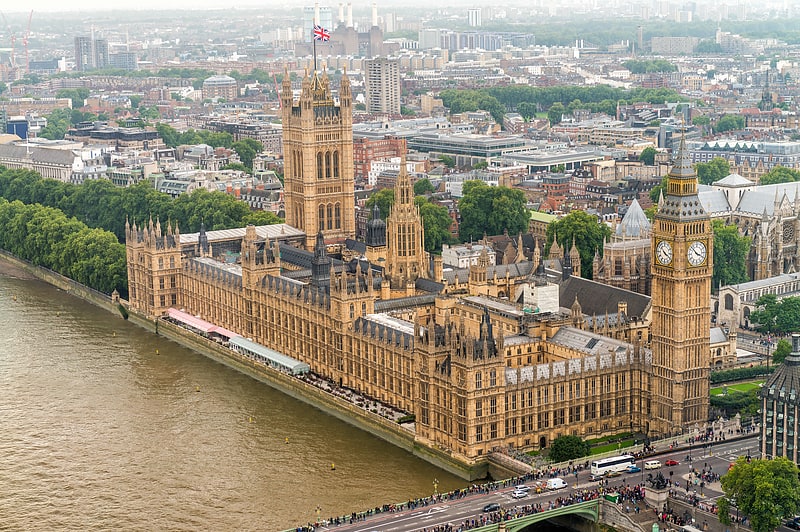
Iconic home of UK parliament. The Palace of Westminster serves as the meeting place for both the House of Commons and the House of Lords, the two houses of the Parliament of the United Kingdom. Informally known as the Houses of Parliament, the Palace lies on the north bank of the River Thames in the City of Westminster, in central London, England.
Its name, which derives from the neighbouring Westminster Abbey, may refer to several historic structures but most often: the Old Palace, a medieval building-complex largely destroyed by fire in 1834, or its replacement, the New Palace that stands today. The palace is owned by the monarch in right of the Crown and, for ceremonial purposes, retains its original status as a royal residence. Committees appointed by both houses manage the building and report to the Speaker of the House of Commons and to the Lord Speaker.
The first royal palace constructed on the site dated from the 11th century, and Westminster became the primary residence of the Kings of England until fire destroyed the royal apartments in 1512 (after which, the nearby Palace of Whitehall was established). The remainder of Westminster continued to serve as the home of the Parliament of England, which had met there since the 13th century, and also as the seat of the Royal Courts of Justice, based in and around Westminster Hall. In 1834 an even greater fire ravaged the heavily rebuilt Houses of Parliament, and the only significant medieval structures to survive were Westminster Hall, the Cloisters of St Stephen's, the Chapel of St Mary Undercroft, and the Jewel Tower.
In the subsequent competition for the reconstruction of the Palace, the architect Charles Barry won with a design for new buildings in the Gothic Revival style, specifically inspired by the English Perpendicular Gothic style of the 14th–16th centuries. The remains of the Old Palace (except the detached Jewel Tower) were incorporated into its much larger replacement, which contains over 1,100 rooms organised symmetrically around two series of courtyards and which has a floor area of 112,476 m2 (1,210,680 sq ft). Part of the New Palace's area of 3.24 hectares (8 acres) was reclaimed from the River Thames, which is the setting of its nearly 300-metre long (980 ft) façade, called the River Front. Augustus Pugin, a leading authority on Gothic architecture and style, assisted Barry and designed the interior of the Palace. Christian themes were integrated into the design. Construction started in 1840 and lasted for 30 years, suffering great delays and cost overruns, as well as the death of both leading architects; works for the interior decoration continued intermittently well into the 20th century. Major conservation work has taken place since then to reverse the effects of London's air pollution, and extensive repairs followed the Second World War, including the reconstruction of the Commons Chamber following its bombing in 1941.
The Palace is one of the centres of political life in the United Kingdom; "Westminster" has become a metonym for the UK Parliament and the British Government, and the Westminster system of government commemorates the name of the palace. The Elizabeth Tower, in particular, often referred to by the name of its main bell, Big Ben, has become an iconic landmark of London and of the United Kingdom in general, one of the most popular tourist attractions in the city, and an emblem of parliamentary democracy. Tsar Nicholas I of Russia called the new palace "a dream in stone". The Palace of Westminster has been a Grade I listed building since 1970 and part of a UNESCO World Heritage Site since 1987.[1]
Address: Parliament Square, SW1A 0AA London (City of Westminster)
Tower of London, London
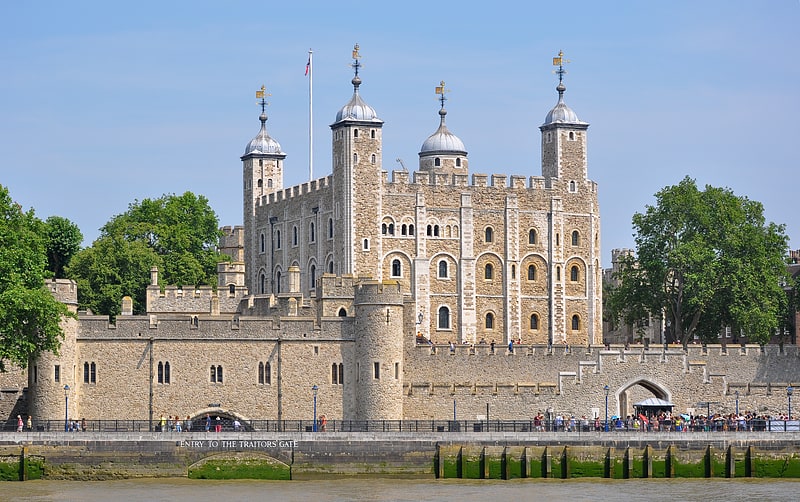
Medieval castle housing the Crown Jewels. The Tower of London, officially Her Majesty's Royal Palace and Fortress of the Tower of London, is a historic castle on the north bank of the River Thames in central London. It lies within the London Borough of Tower Hamlets, which is separated from the eastern edge of the square mile of the City of London by the open space known as Tower Hill. It was founded towards the end of 1066 as part of the Norman Conquest. The White Tower, which gives the entire castle its name, was built by William the Conqueror in 1078 and was a resented symbol of oppression, inflicted upon London by the new ruling elite. The castle was also used as a prison from 1100 until 1952, although that was not its primary purpose. A grand palace early in its history, it served as a royal residence. As a whole, the Tower is a complex of several buildings set within two concentric rings of defensive walls and a moat. There were several phases of expansion, mainly under kings Richard I, Henry III, and Edward I in the 12th and 13th centuries. The general layout established by the late 13th century remains despite later activity on the site.
The Tower of London has played a prominent role in English history. It was besieged several times, and controlling it has been important to controlling the country. The Tower has served variously as an armoury, a treasury, a menagerie, the home of the Royal Mint, a public record office, and the home of the Crown Jewels of England. From the early 14th century until the reign of Charles II in the 17th century, a procession would be led from the Tower to Westminster Abbey on the coronation of a monarch. In the absence of the monarch, the Constable of the Tower is in charge of the castle. This was a powerful and trusted position in the medieval period. In the late 15th century, the Princes in the Tower were housed at the castle when they mysteriously disappeared, presumed murdered. Under the Tudors, the Tower became used less as a royal residence, and despite attempts to refortify and repair the castle, its defences lagged behind developments to deal with artillery.
The zenith of the castle's use as a prison was the 16th and 17th centuries, when many figures who had fallen into disgrace, such as Elizabeth I before she became queen, Sir Walter Raleigh, and Elizabeth Throckmorton, were held within its walls. This use has led to the phrase "sent to the Tower". Despite its enduring reputation as a place of torture and death, popularised by 16th-century religious propagandists and 19th-century writers, only seven people were executed within the Tower before the World Wars of the 20th century. Executions were more commonly held on the notorious Tower Hill to the north of the castle, with 112 occurring there over a 400-year period. In the latter half of the 19th century, institutions such as the Royal Mint moved out of the castle to other locations, leaving many buildings empty. Anthony Salvin and John Taylor took the opportunity to restore the Tower to what was felt to be its medieval appearance, clearing out many of the vacant post-medieval structures.
In the First and Second World Wars, the Tower was again used as a prison and witnessed the executions of 12 men for espionage. After the Second World War, damage caused during the Blitz was repaired, and the castle reopened to the public. Today, the Tower of London is one of the country's most popular tourist attractions. Under the ceremonial charge of the Constable of the Tower, and operated by the Resident Governor of the Tower of London and Keeper of the Jewel House, the property is cared for by the charity Historic Royal Palaces and is protected as a World Heritage Site.[2]
Address: Tower Hill, EC3N 4DR London (Tower Hamlets)
Kew Gardens, London
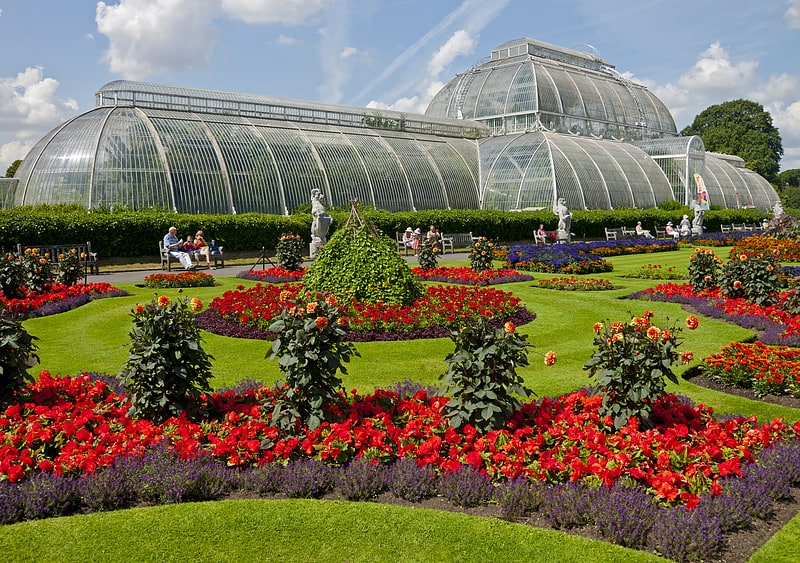
Plants from the Arctic to the Tropics. Kew Gardens is a botanic garden in southwest London that houses the "largest and most diverse botanical and mycological collections in the world". Founded in 1840, from the exotic garden at Kew Park, its living collections includes some of the 27,000 taxa curated by Royal Botanic Gardens, Kew, while the herbarium, one of the largest in the world, has over 8.5 million preserved plant and fungal specimens. The library contains more than 750,000 volumes, and the illustrations collection contains more than 175,000 prints and drawings of plants. It is one of London's top tourist attractions and is a World Heritage Site.
Kew Gardens, together with the botanic gardens at Wakehurst in Sussex, are managed by the Royal Botanic Gardens, Kew, an internationally important botanical research and education institution that employs over 1,100 staff and is a non-departmental public body sponsored by the Department for Environment, Food and Rural Affairs.
The Kew site, which has been dated as formally starting in 1759, although it can be traced back to the exotic garden at Kew Park, formed by Henry, Lord Capell of Tewkesbury, consists of 132 hectares (330 acres) of gardens and botanical glasshouses, four Grade I listed buildings, and 36 Grade II listed structures, all set in an internationally significant landscape. It is listed Grade I on the Register of Historic Parks and Gardens.
Kew Gardens has its own police force, Kew Constabulary, which has been in operation since 1847.[3]
Address: Kew Rd, TW9 3AB Kew (Richmond upon Thames)
Edinburgh Castle, Edinburgh
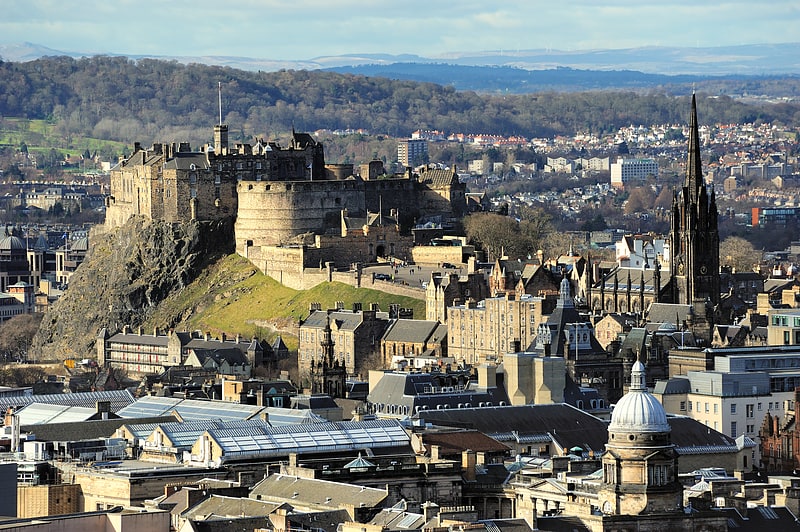
Spectacular old fortress with city views. Edinburgh Castle is a historic castle in Edinburgh, Scotland. It stands on Castle Rock, which has been occupied by humans since at least the Iron Age, although the nature of the early settlement is unclear. There has been a royal castle on the rock since at least the reign of David I in the 12th century, and the site continued to be a royal residence until 1633. From the 15th century, the castle's residential role declined, and by the 17th century it was principally used as military barracks with a large garrison. Its importance as a part of Scotland's national heritage was recognised increasingly from the early 19th century onwards, and various restoration programmes have been carried out over the past century and a half.
As one of the most important strongholds in the Kingdom of Scotland, Edinburgh Castle was involved in many historical conflicts from the Wars of Scottish Independence in the 14th century to the Jacobite rising of 1745. Research undertaken in 2014 identified 26 sieges in its 1,100-year history, giving it a claim to having been "the most besieged place in Great Britain and one of the most attacked in the world". Few of the present buildings pre-date the Lang Siege of the 16th century when the medieval defences were largely destroyed by artillery bombardment. The most notable exceptions are St Margaret's Chapel from the early 12th century, which is regarded as the oldest building in Edinburgh, the Royal Palace, and the early 16th-century Great Hall, although the interiors have been much altered from the mid-Victorian period onwards. The castle also houses the Scottish regalia, known as the Honours of Scotland, and is the site of the Scottish National War Memorial and the National War Museum of Scotland. The British Army is still responsible for some parts of the castle, although its presence is now largely ceremonial and administrative. Some of the castle buildings house regimental museums which contribute to its presentation as a tourist attraction.
The castle, in the care of Historic Environment Scotland, is Scotland's most and the United Kingdom's second most-visited paid tourist attraction, with over 2.2 million visitors in 2019 and over 70 percent of leisure visitors to Edinburgh visiting the castle. As the backdrop to the Royal Edinburgh Military Tattoo during the annual Edinburgh Festival, the castle has become a recognisable symbol of Edinburgh in particular and of Scotland as a whole.[4]
Palace of Holyroodhouse, Edinburgh
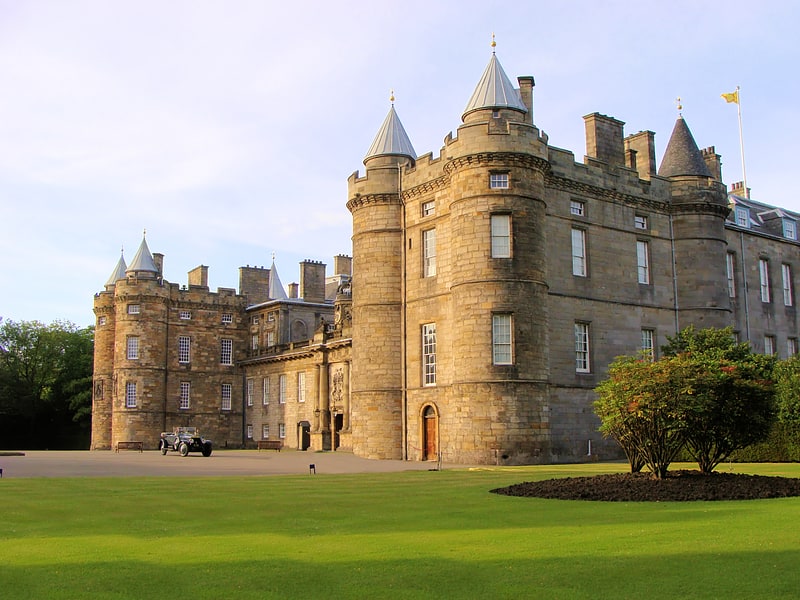
16th-century royal palace and abbey . The Palace of Holyroodhouse, commonly referred to as Holyrood Palace or Holyroodhouse, or Holyrood Castle, is the official residence of the British monarch in Scotland. Located at the bottom of the Royal Mile in Edinburgh, at the opposite end to Edinburgh Castle, Holyroodhouse has served as the principal royal residence in Scotland since the 16th century, and is a setting for state occasions and official entertaining.
Queen Elizabeth II spends one week in residence at Holyroodhouse at the beginning of each summer, where she carries out a range of official engagements and ceremonies. The 16th-century historic apartments of Mary, Queen of Scots, and the State Apartments, used for official and state entertaining, are open to the public throughout the year, except when members of the Royal Family are in residence. The Queen's Gallery was built at the western entrance to the Palace of Holyroodhouse and opened in 2002 to exhibit works of art from the Royal Collection. The gardens of the palace are set within Holyrood Park.[5]
Scottish National Gallery, Edinburgh
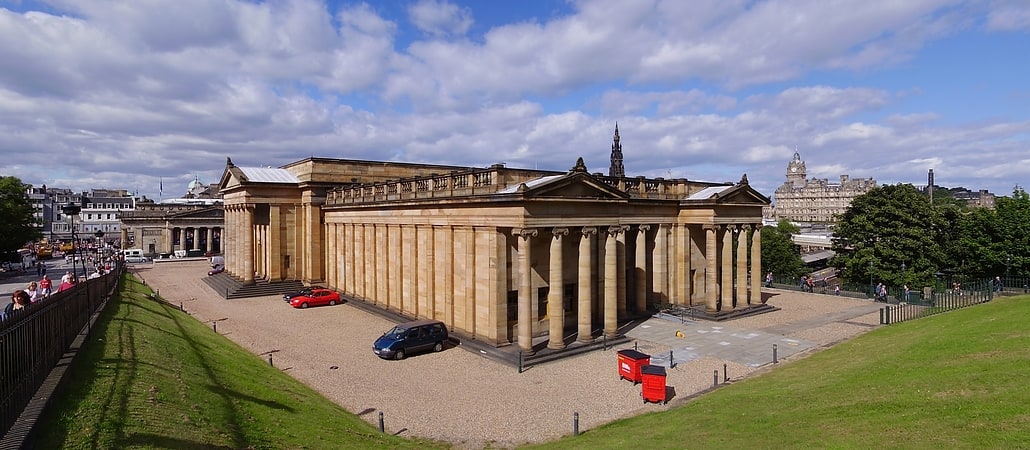
Old Masters and Scottish masterpieces. The Scottish National Gallery is the national art gallery of Scotland. It is located on The Mound in central Edinburgh, close to Princes Street. The building was designed in a neoclassical style by William Henry Playfair, and first opened to the public in 1859.
The gallery houses Scotland's national collection of fine art, spanning Scottish and international art from the beginning of the Renaissance up to the start of the 20th century.
The Scottish National Gallery is run by National Galleries of Scotland, a public body that also owns the Scottish National Gallery of Modern Art and the Scottish National Portrait Gallery. Because of its architectural similarity, the Scottish National Gallery is frequently confused by visitors with the neighbouring Royal Scottish Academy Building (RSA), a separate institution which works closely with the Scottish National Gallery.[6]
Address: The Mound, EH2 2EL Edinburgh (Old Town)
Roman Baths, Bath

Thermae in Bath, England. The Roman Baths are well-preserved thermae in the city of Bath, Somerset, England. A temple was constructed on the site between 60-70AD in the first few decades of Roman Britain. Its presence led to the development of the small Roman urban settlement known as Aquae Sulis around the site. The Roman baths—designed for public bathing—were used until the end of Roman rule in Britain in the 5th Century AD. According to the Anglo-Saxon Chronicle, the original Roman baths were in ruins a century later. The area around the natural springs was redeveloped several times during the Early and Late Middle Ages.
The Roman Baths are preserved in four main features: the Sacred Spring, the Roman Temple, the Roman Bath House, and a museum which holds artefacts from Aquae Sulis. However, all buildings at street level date from the 19th century. It is a major tourist attraction in the UK, and together with the Grand Pump Room, receives more than 1.3 million visitors annually. Visitors can tour the baths and museum but cannot enter the water.[7]
Address: Stall St, BA1 1LZ Bath
Museum of Science and Industry, Manchester

History in an 1830 railway station. The Science and Industry Museum in Manchester, England, traces the development of science, technology and industry with emphasis on the city's achievements in these fields. The museum is part of the Science Museum Group, a non-departmental public body of the Department for Digital, Culture, Media and Sport, having merged with the National Science Museum in 2012.
There are extensive displays on the theme of transport (cars, aircraft, railway locomotives and rolling stock), power (water, electricity, steam and gas engines), Manchester's sewerage and sanitation, textiles, communications and computing.
The museum is an Anchor Point of the European Route of Industrial Heritage and is on the site of the world's first passenger railway station – Manchester Liverpool Road – which opened as part of the Liverpool & Manchester Railway in 1830. The railway station frontage and 1830 warehouse are both Grade I listed.[8]
Address: Liverpool Road, M3 4FP Manchester
Manchester Art Gallery, Manchester

Prominent paintings and decorative arts. Manchester Art Gallery, formerly Manchester City Art Gallery, is a publicly owned art museum on Mosley Street in Manchester city centre. The main gallery premises were built for a learned society in 1823 and today its collection occupies three connected buildings, two of which were designed by Sir Charles Barry. Both Barry's buildings are listed. The building that links them was designed by Hopkins Architects following an architectural design competition managed by RIBA Competitions. It opened in 2002 following a major renovation and expansion project undertaken by the art gallery.
Manchester Art Gallery is free to enter and open seven days a week. It houses many works of local and international significance and has a collection of more than 25,000 objects. More than half a million people visited the museum in the period of a year, according to figures released in April 2014.[9]
Address: Mosley St, M2 3JL Manchester
Church Street, Liverpool
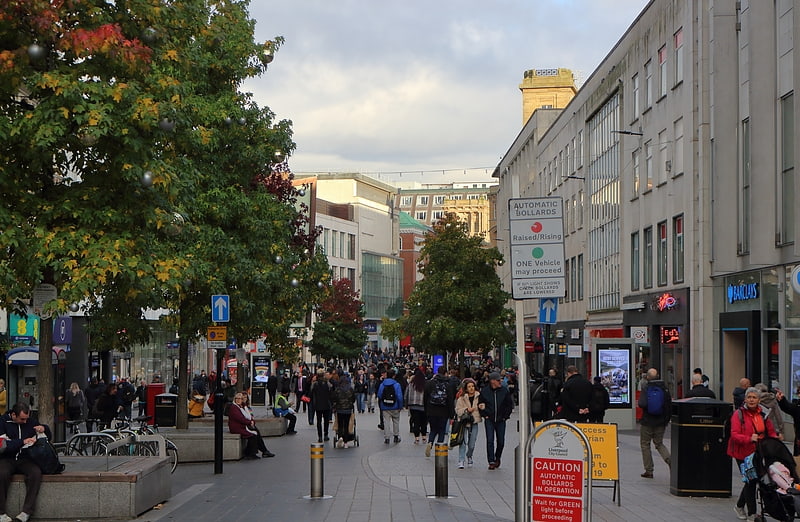
Church Street is a street in Liverpool, England, lying between Bold Street to the east and Lord Street to the west. It is the main shopping area of Liverpool and takes its name from St Peter's Church, which was demolished in 1922. The side streets to the north of Church Street lead to Williamson Square, while the Grade I listed Bluecoat Chambers—the oldest surviving building in Liverpool—is to the south along Church Alley. The Liverpool Athenaeum, an institution founded in the 18th century, is also on Church Alley. The area behind the shops on the south side of Church Street is now part of the Liverpool One shopping complex, which opened in October 2008 after the redevelopment of a large part of the L1 postcode area.[10]
Address: Church St, Liverpool
High Street, Oxford
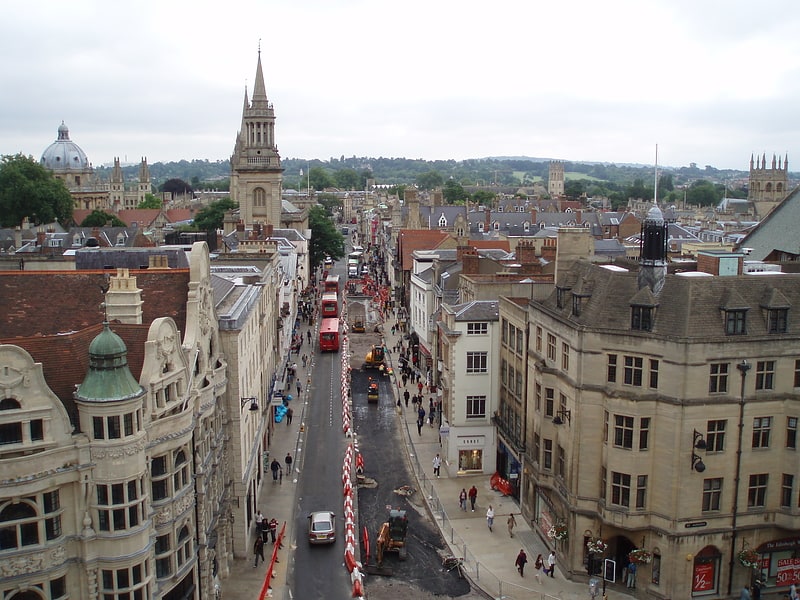
Street in Oxford, England. The High Street in Oxford, England, known locally as the High, runs between Carfax, generally seen as the centre of the city, and Magdalen Bridge to the east.[11]
Address: High St, OX1 Oxford
Kelvingrove Art Gallery and Museum, Glasgow
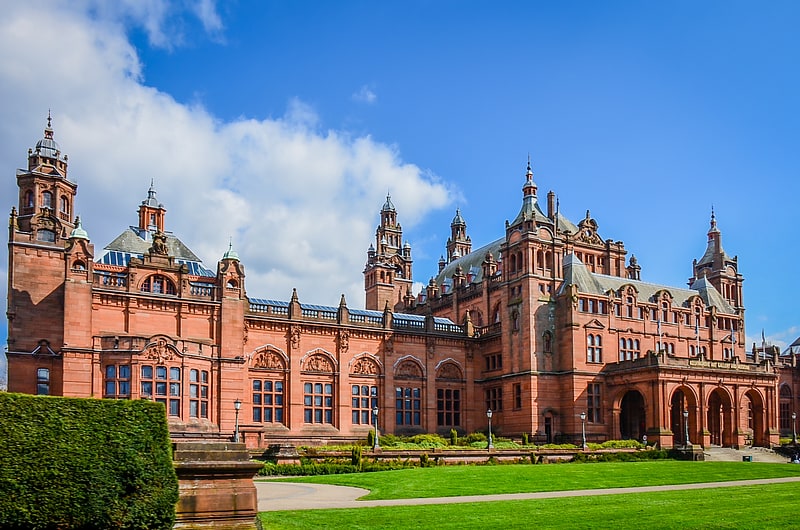
Grand building of art and natural history. Kelvingrove Art Gallery and Museum is a museum and art gallery in Glasgow, Scotland. It reopened in 2006 after a three-year refurbishment and since then has been one of Scotland's most popular visitor attractions. The museum has 22 galleries, housing a range of exhibits, including Renaissance art, taxidermy, and artifacts from ancient Egypt.[12]
Address: Argyle St, G3 8AG Glasgow (West End)
Cornmarket Street, Oxford
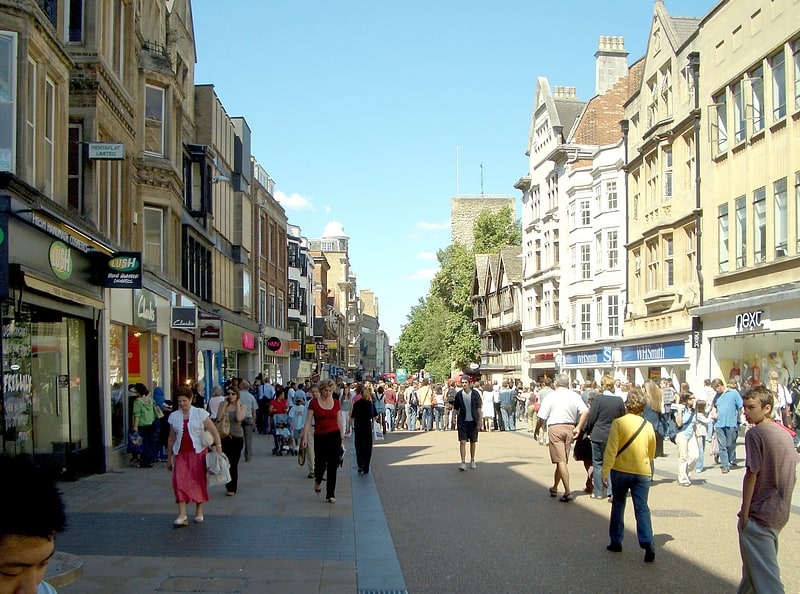
Street in Oxford, England. Cornmarket Street is a major shopping street and pedestrian precinct in Oxford, England that runs north to south between Magdalen Street and Carfax Tower.
To the east is the Golden Cross arcade of small jewellery and craft shops in a courtyard, leading to the Covered Market. To the west is the indoor Clarendon Shopping Centre that connects in an L-shape to Queen Street.
Cornmarket was semi-pedestrianised and made a limited-access street in 1999. Cycling is allowed 6pm to 10am. In 2002, it was voted Britain's second worst street in a poll of listeners to the Today programme. The rating was largely due to a failed attempt to repave the street in 2001. The granite setts, which had been laid extensively, cracked and the contractor went into liquidation. In 2003, it was repaved again and new benches installed, amidst reports of budgetary problems.[13]
Address: Cornmarket Street, OX1 3EY Oxford
Imperial War Museum North, Manchester
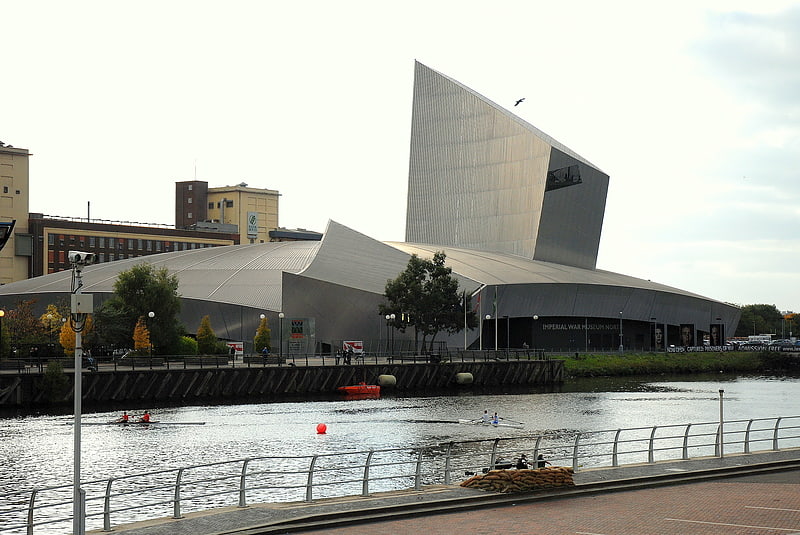
Museum of conflict in symbolic building. Imperial War Museum North is a museum in the Metropolitan Borough of Trafford in Greater Manchester, England. One of five branches of the Imperial War Museum, it explores the impact of modern conflicts on people and society. It is the first branch of the Imperial War Museum to be located in the north of England. The museum occupies a site overlooking the Manchester Ship Canal on Trafford Wharf Road, Trafford Park, an area which during the Second World War was a key industrial centre and consequently heavily bombed during the Manchester Blitz in 1940. Just across the Trafford Wharf Road from the Museum is the bulk of the Rank Hovis Flour Mill, a survivor from a former industrial age and now rather out of keeping with the surrounding architecture. The area is now home to the Lowry cultural centre and the MediaCityUK development, which stand opposite the museum at Salford Quays.
The museum building was designed by architect Daniel Libeskind and opened in July 2002, receiving 470,000 visitors in its first year of opening. It was recognised with awards or prize nominations for its architecture and is a prime example of Deconstructivist architecture. The museum features a permanent exhibition of chronological and thematic displays, supported by hourly audiovisual presentations which are projected throughout the gallery space. The museum also hosts a programme of temporary exhibitions in a separate gallery. Since opening, the museum has operated a successful volunteer programme, which since January 2007 has been run in partnership with Manchester Museum. As part of a national museum, Imperial War Museum North is financed by the Department for Culture, Media and Sport and by self-generated income. Admission is free.[14]
Address: Trafford Wharf Rd, M17 1TZ Manchester (Trafford)
Broad Street, Oxford
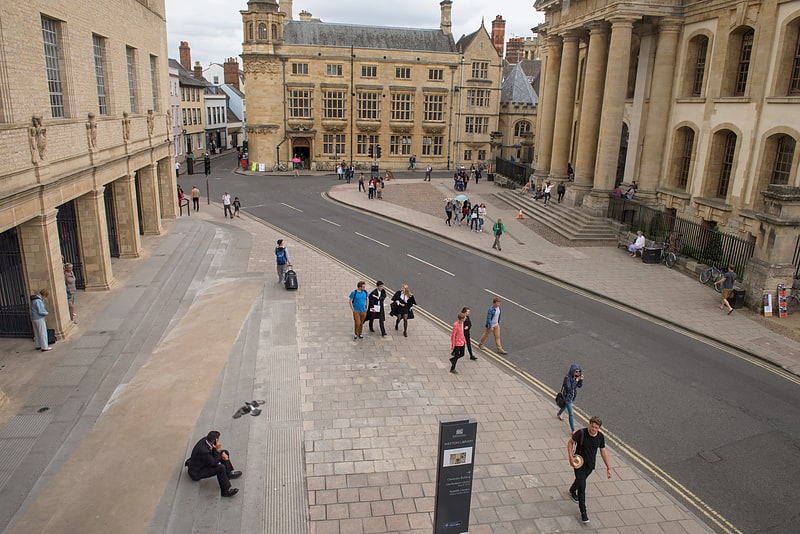
Street in Oxford, England. Broad Street is a wide street in central Oxford, England, just north of the former city wall. The street is known for its bookshops, including the original Blackwell's bookshop at number 50, located here due to the University of Oxford. Among residents, the street is traditionally known as The Broad.[15]
Address: Broad St, OX1 Oxford
Riverside Museum, Glasgow

The Riverside Museum is the location of the Glasgow Museum of Transport, at Pointhouse Quay in the Glasgow Harbour regeneration district of Glasgow, Scotland. The building opened in June 2011. The museum won the 2013 European Museum of the Year Award.[16]
Address: Riverside Museum 100 Pointhouse Place, G3 8RS Glasgow (West End)
Bath Abbey, Bath
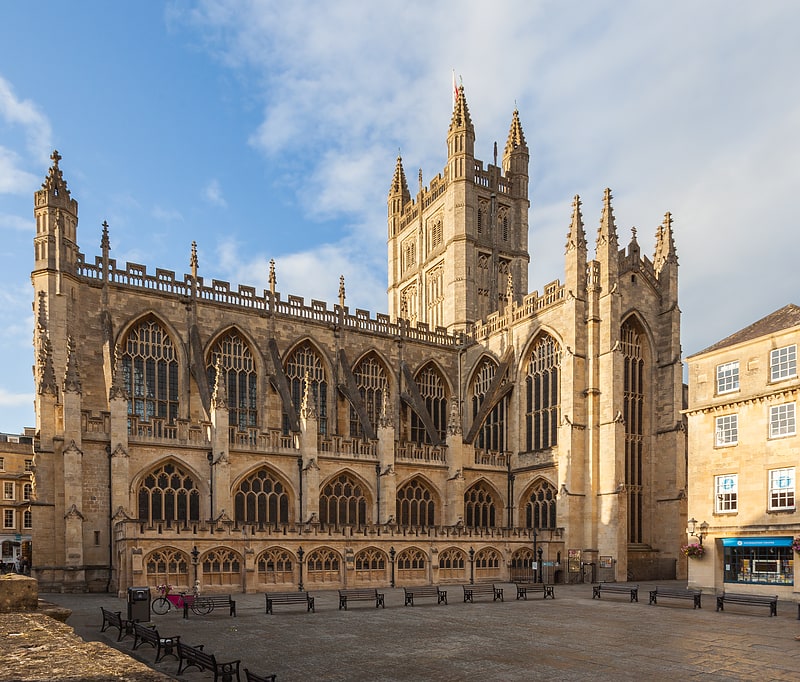
Medieval building with a Gothic interior. Bath Abbey is a parish church of the Church of England and former Benedictine monastery in Bath, Somerset, England. Founded in the 7th century, it was reorganised in the 10th century and rebuilt in the 12th and 16th centuries; major restoration work was carried out by Sir George Gilbert Scott in the 1860s. It is one of the largest examples of Perpendicular Gothic architecture in the West Country. The medieval abbey church served as a sometime cathedral of a bishop. After long contention between churchmen in Bath and Wells the seat of the Diocese of Bath and Wells was later consolidated at Wells Cathedral. The Benedictine community was dissolved in 1539 during the Dissolution of the Monasteries.
The church architecture is cruciform in plan and can seat up to 1,200 patrons. An active place of worship, it also hosts civic ceremonies, concerts and lectures. There is a heritage museum in the cellars.
The abbey is a Grade I listed building, particularly noted for its fan vaulting. It contains war memorials for the local population and monuments to several notable people, in the form of wall and floor plaques and commemorative stained glass. The church has two organs and a peal of ten bells. The west front includes sculptures of angels climbing to heaven on two stone ladders, representing Jacob's Ladder.[17]
Address: 12 Kingston Buildings, BA1 1LT Bath
National Railway Museum, York

Museum in York, England. The National Railway Museum is a museum in York forming part of the Science Museum Group. The museum tells the story of rail transport in Britain and its impact on society. It is the home of the national collection of historically significant railway vehicles such as Mallard, Stirling Single, Duchess of Hamilton and a Japanese bullet train. In addition, the National Railway Museum holds a diverse collection of other objects from a household recipe book used in George Stephenson's house to film showing a "never-stop railway" developed for the British Empire Exhibition. It has won many awards, including the European Museum of the Year Award in 2001.
As of 2019 the museum is about to embark on a major site development. As part of the York Central redevelopment which will divert Leeman Road, the National Railway Museum will be building a new entrance building to connect the two separate parts of the museum together. At the same time, the space around the museum will be landscaped to provide public spaces.
In 2020 architectural practice Feilden Fowles won an international competition to create the museum's new £16.5 million Central Hall building—a key element of the museum's Vision 2025 masterplan.[18]
Address: Leeman Road, YO26 4XJ York
Tate Liverpool, Liverpool
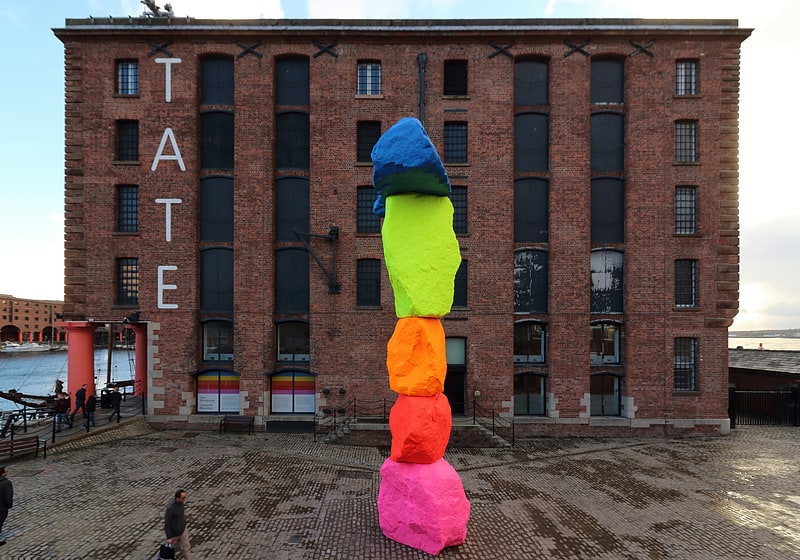
Modern art in former dock warehouses. Tate Liverpool is an art gallery and museum in Liverpool, Merseyside, England, and part of Tate, along with Tate St Ives, Cornwall, Tate Britain, London, and Tate Modern, London. The museum was an initiative of the Merseyside Development Corporation. Tate Liverpool was created to display work from the Tate Collection which comprises the national collection of British art from the year 1500 to the present day, and international modern art. The gallery also has a programme of temporary exhibitions. Until 2003, Tate Liverpool was the largest gallery of modern and contemporary art in the UK outside London.[19]
Address: Albert Dock, L3 4BB Liverpool
Gallery of Modern Art, Glasgow

Art gallery in Glasgow, Scotland. The Gallery of Modern Art is the main gallery of contemporary art in Glasgow, Scotland.
GoMA offers a programme of temporary exhibitions and workshops. GoMA displays work by local and international artists as well as addressing contemporary social issues through its major biannual projects.[20]
Address: 111 Queen Street, G1 3AH Glasgow (City Centre)
World Museum, Liverpool
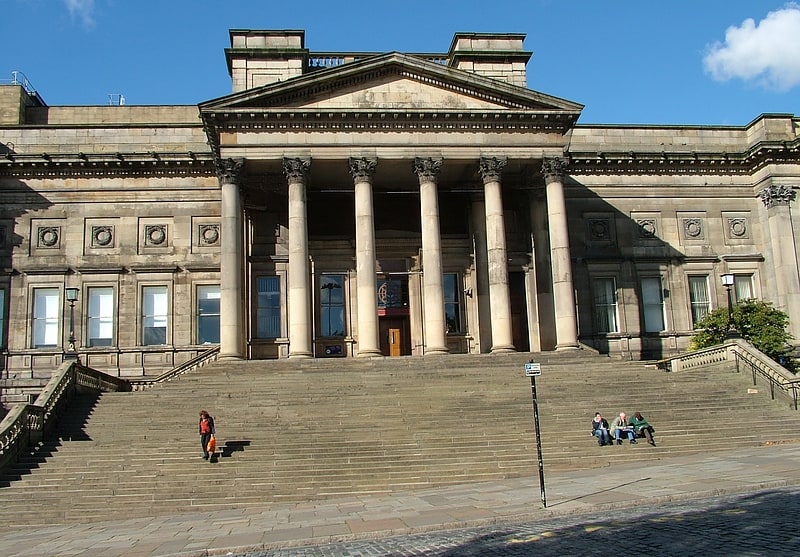
Museum in Liverpool, England. World Museum is a large museum in Liverpool, England which has extensive collections covering archaeology, ethnology and the natural and physical sciences. Special attractions include the Natural History Centre and a planetarium. Entry to the museum is free. The museum is part of National Museums Liverpool.[21]
Address: William Brown St, L3 8EN Liverpool
M Shed, Bristol

Museum in Bristol, England. M Shed is a museum in Bristol, England, located on Prince's Wharf beside the Floating Harbour in a dockside transit shed formerly occupied by Bristol Industrial Museum. The museum's name is derived from the way that the port identified each of its sheds. M Shed is home to displays of 3,000 Bristol artefacts and stories, showing Bristol's role in the slave trade and items on transport, people, and the arts. Admission is free.
The museum opened in June 2011, with exhibits exploring life and work in the city. In its first year, 700,000 people visited the new museum.
Normally moored in front of the museum is a collection of historic vessels, which include a 1934 fireboat (the Fire-float Pyronaut), and two tugboats (Mayflower, the world's oldest surviving steam tug, and John King, a 1935 diesel tug).
The museum contains a shop, learning space and cafe.[22]
Address: Wapping Rd, BS1 4RN Bristol
Birmingham Museum and Art Gallery, Birmingham
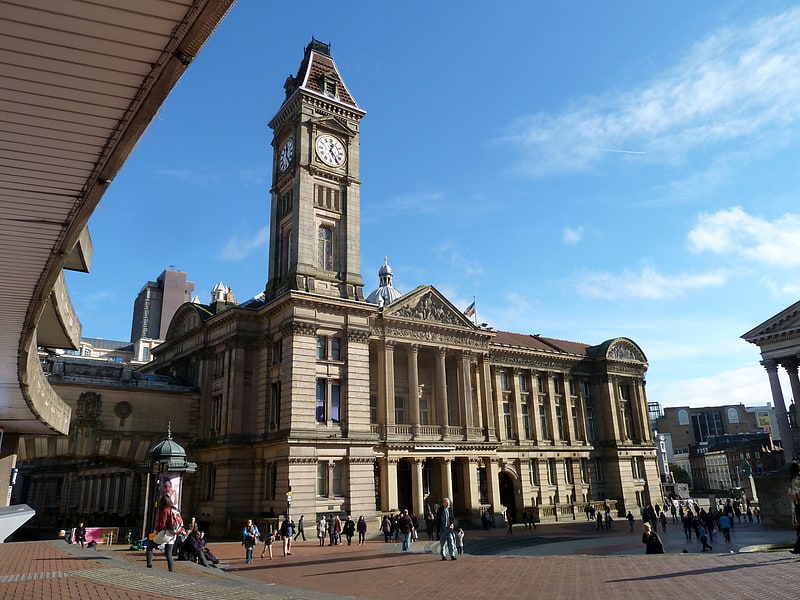
Museum in Birmingham, England. Birmingham Museum and Art Gallery is a museum and art gallery in Birmingham, England. It has a collection of international importance covering fine art, ceramics, metalwork, jewellery, natural history, archaeology, ethnography, local history and industrial history.
The museum/gallery is run by Birmingham Museums Trust, the largest independent museums trust in the United Kingdom, which also runs eight other museums around the city. Entrance to the Museum and Art Gallery is free, but some major exhibitions in the Gas Hall incur an entrance fee.[23]
Address: Chamberlain Square, B3 3DH Birmingham
Bristol Museum & Art Gallery, Bristol
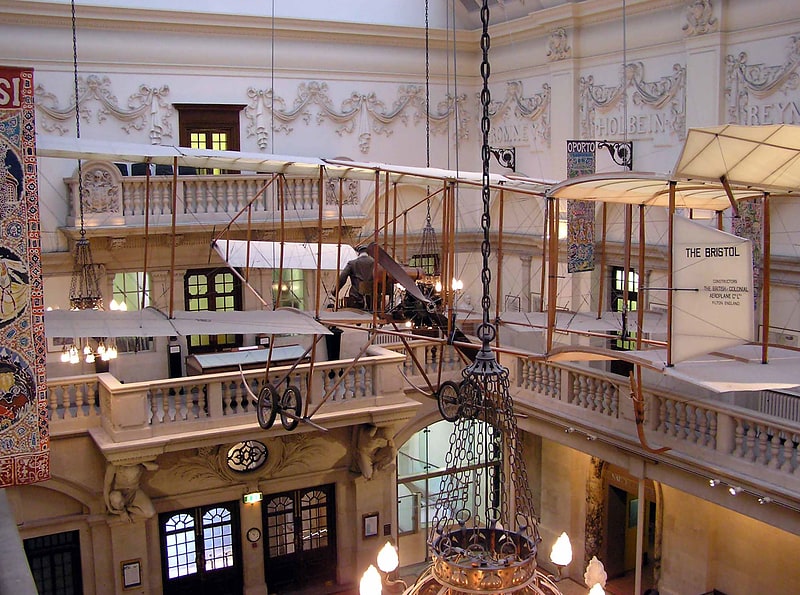
Museum in Bristol, England. Bristol Museum & Art Gallery is a large museum and art gallery in Bristol, England. The museum is situated in Clifton, about 0.5 miles from the city centre. As part of Bristol Culture it is run by the Bristol City Council with no entrance fee. It holds designated museum status, granted by the national government to protect outstanding museums. The designated collections include: geology, Eastern art, and Bristol's history, including English delftware. In January 2012 it became one of sixteen Arts Council England Major Partner Museums.
The museum includes sections on natural history as well as local, national and international archaeology. The art gallery contains works from all periods, including many by internationally famous artists, as well a collection of modern paintings of Bristol.
In the summer of 2009 the museum hosted an exhibition by Banksy featuring more than 70 works of art, including animatronics and installations; it is his largest exhibition yet. It was developed in secrecy and with no advance publicity, but soon gained worldwide attention.
The building is of Edwardian Baroque architecture and has been designated by English Heritage as a grade II* listed building.
The standard opening hours are: Tuesday to Sunday, 10am–5pm. The museum is also open 10am–5pm on Bank Holiday Mondays and Mondays during Bristol school holidays.[24]
Address: Queens Road, BS8 1RL Bristol
National Museum Cardiff, Cardiff
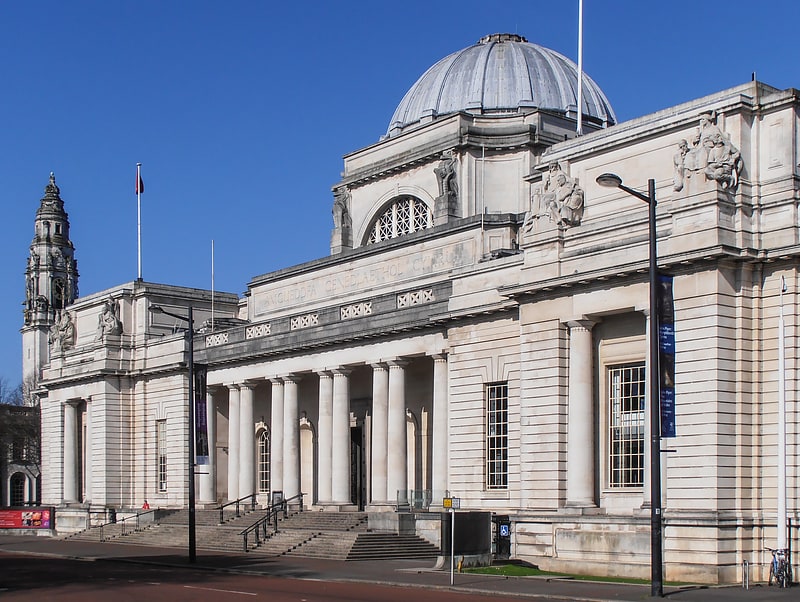
Art and Welsh history in a grand setting. National Museum Cardiff is a museum and art gallery in Cardiff, Wales. The museum is part of the wider network of Amgueddfa Cymru – National Museum Wales. Entry is kept free by a grant from the Welsh Government; however, they do ask for donations throughout the museum.[25]
Address: Cathays Park, CF10 3NP Cardiff (Canol Dinas Caerdydd)
Arnolfini, Bristol
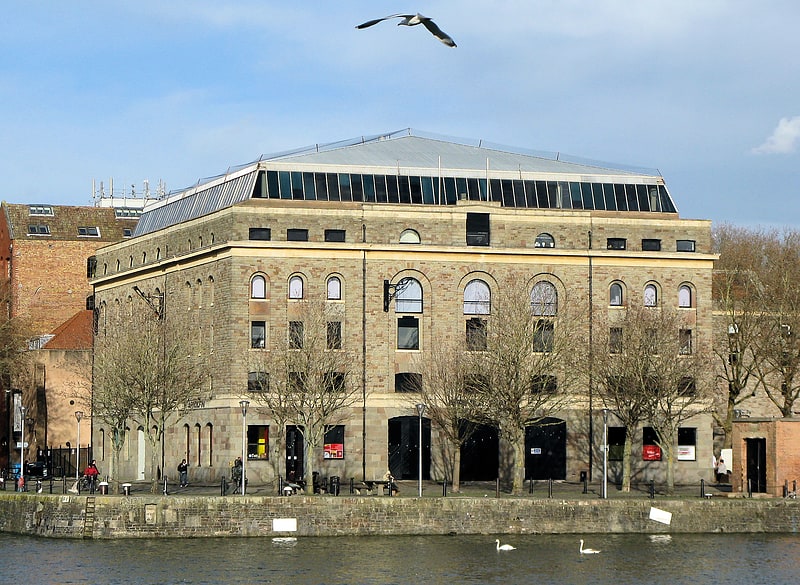
Art gallery in Bristol, England. Arnolfini is an international arts centre and gallery in Bristol, England. It has a programme of contemporary art exhibitions, artist's performance, music and dance events, poetry and book readings, talks, lectures and cinema. There is also a specialist art bookshop and a café bar. Educational activities are undertaken and experimental digital media work supported by online resources. Festivals are hosted by the gallery.
The gallery was founded in 1961 by Jeremy Rees, and was located in Clifton. In the 1970s it moved to Queen Square, before moving to its present location, Bush House on Bristol's waterfront, in 1975. The name of the gallery is taken from Jan van Eyck's 15th-century painting The Arnolfini Portrait. Arnolfini was refurbished and redeveloped in 1989 and 2005. Artists whose work has been exhibited include Bridget Riley, Rachel Whiteread, Richard Long and Jack Yeats. Performers have included Goat Island Performance Group, the Philip Glass Ensemble, and Shobana Jeyasingh Dance Company. The gallery reached a new audience in April 2010, when it was chosen to host one of the three 2010 general election debates.[26]
Address: 16 Narrow Quay, BS1 4QA Bristol
Northumberland Street, Newcastle upon Tyne

Street in Newcastle upon Tyne, England. Northumberland Street is a major shopping street in the city of Newcastle upon Tyne, in the North East of England. It is home to a wide range of different retailers, banks and cafes, and in terms of rental per square foot, Northumberland Street is the most expensive location in the UK outside London to own a shop. There are currently over 51 retailers including pubs on Newcastle's Northumberland Street.[27]
Address: Northumberland St, NE1 Newcastle upon Tyne
Great North Museum: Hancock, Newcastle upon Tyne
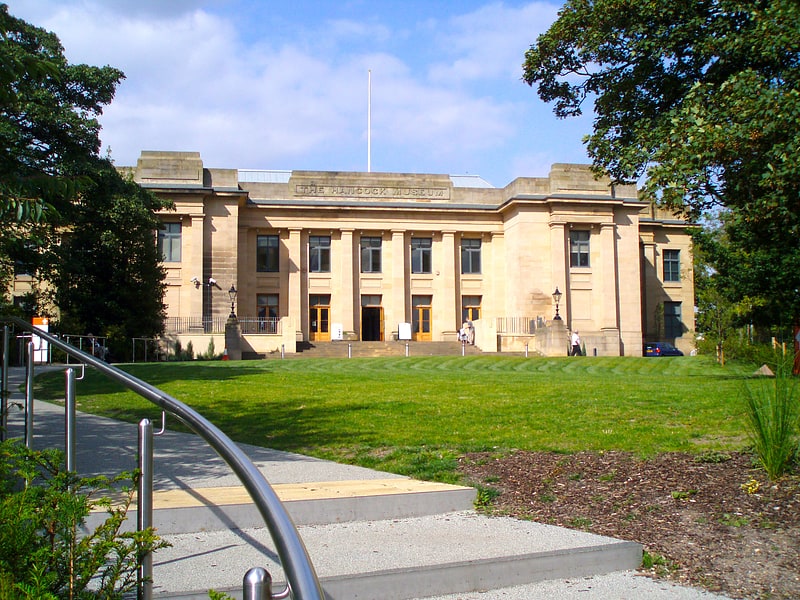
Museum in Newcastle upon Tyne, England. The Great North Museum: Hancock is a museum of natural history and ancient civilisations in Newcastle upon Tyne, England.
The museum was established in 1884 and was formerly known as the Hancock Museum. In 2006 it merged with Newcastle University's Museum of Antiquities and Shefton Museum to form the Great North Museum. The museum reopened as the Great North Museum: Hancock in May 2009 following a major extension and refurbishment of the original Victorian building. The museum and most of its collections are owned by the Natural History Society of Northumbria, and it is managed by Tyne & Wear Archives & Museums on behalf of Newcastle University.[28]
Address: Barras Bridge, NE2 4PT Newcastle upon Tyne
St Fagans National History Museum, Cardiff
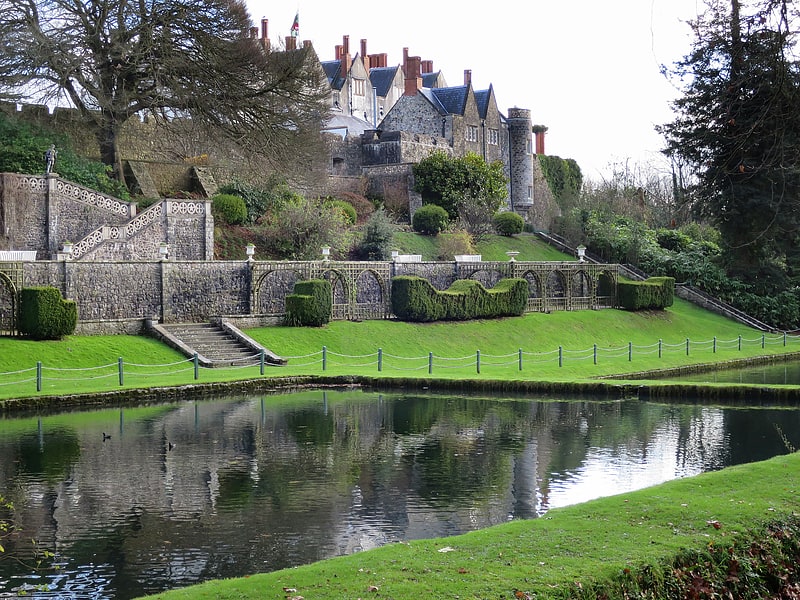
Museum in Cardiff, Wales. St Fagans National Museum of History, commonly referred to as St Fagans after the village where it is located, is an open-air museum in Cardiff chronicling the historical lifestyle, culture, and architecture of the Welsh people. The museum is part of the wider network of Amgueddfa Cymru – National Museum Wales.
It consists of more than forty re-erected buildings from various locations in Wales, and is set in the grounds of St Fagans Castle, a Grade I listed Elizabethan manor house. In 2011 Which? magazine named the museum the United Kingdom's favourite visitor attraction.
A six-year, £30-million revamp was completed in 2018 and the museum was named the Art Fund Museum of the Year in 2019.[29]
Address: Michaelston Rd, CF5 6XB Saint Fagans (Gorllewin Caerdydd)
Fitzwilliam Museum, Cambridge

Antique and modern art and artefacts. The Fitzwilliam Museum is the art and antiquities museum of the University of Cambridge. It is located on Trumpington Street opposite Fitzwilliam Street in central Cambridge. It was founded in 1816 under the will of Richard FitzWilliam, 7th Viscount FitzWilliam, and comprises one of the best collections of antiquities and modern art in western Europe. With over half a million objects and artworks in its collections, the displays in the Museum explore world history and art from antiquity to the present. The treasures of the museum include artworks by Monet, Picasso, Rubens, Vincent van Gogh, Rembrandt, Cézanne, Van Dyck, and Canaletto, as well as a winged bas-relief from Nimrud. Admission to the public is always free.
The museum is a partner in the University of Cambridge Museums consortium, one of 16 Major Partner Museum services funded by Arts Council England to lead the development of the museums sector.[30]
Address: Trumpington St, CB2 1RB Cambridge
Centre for Life, Newcastle upon Tyne
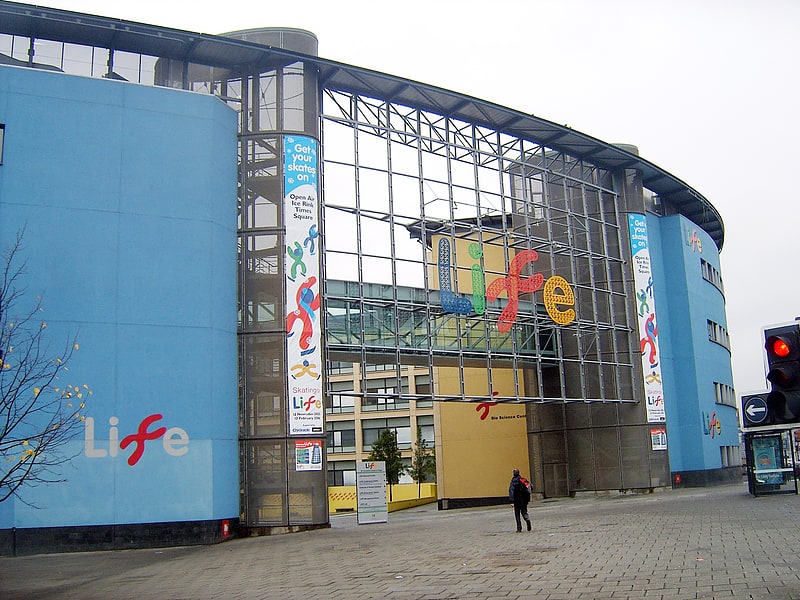
Science museum in Newcastle upon Tyne, England. The Centre for Life is a science village in Newcastle upon Tyne where scientists, clinicians, educationalists and business people work to promote the advancement of the life sciences. The centre is a registered charity, governed by a board of trustees, which receives no public funding.[31]
Address: Times Square, NE1 4EP Newcastle upon Tyne
York Minster, York
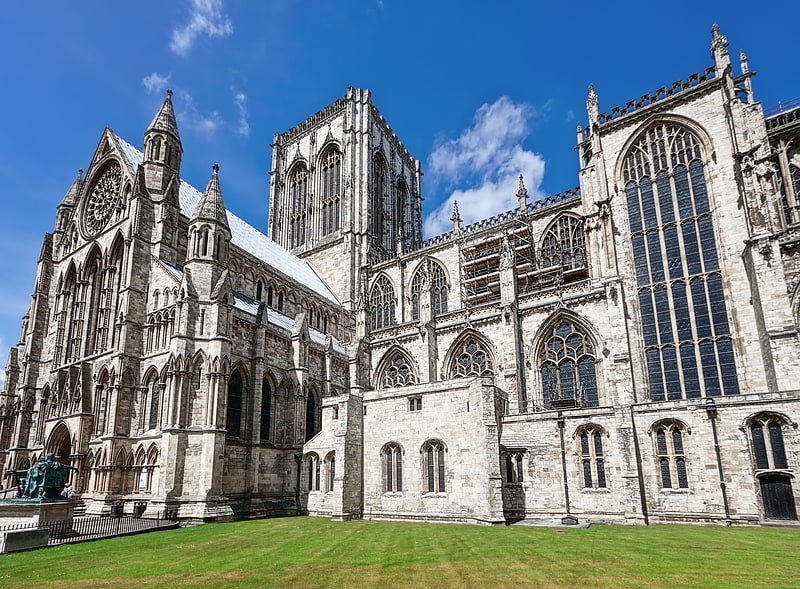
Iconic Gothic-style Medieval cathedral. The Cathedral and Metropolitical Church of Saint Peter in York, commonly known as York Minster, is the cathedral of York, North Yorkshire, England, and is one of the largest of its kind in Northern Europe. The minster is the seat of the Archbishop of York, the third-highest office of the Church of England, and is the mother church for the Diocese of York and the Province of York. It is run by a dean and chapter, under the Dean of York. The title "minster" is attributed to churches established in the Anglo-Saxon period as missionary teaching churches, and serves now as an honorific title; the word Metropolitical in the formal name refers to the Archbishop of York's role as the Metropolitan bishop of the Province of York. Services in the minster are sometimes regarded as on the High Church or Anglo-Catholic end of the Anglican continuum.
The minster was completed in 1472 after several centuries of building. It is devoted to Saint Peter, and has a very wide Decorated Gothic nave and chapter house, a Perpendicular Gothic quire and east end and Early English North and South transepts. The nave contains the West Window, constructed in 1338, and over the Lady Chapel in the east end is the Great East Window (finished in 1408), the largest expanse of medieval stained glass in the world. In the north transept is the Five Sisters window, each lancet being over 53 feet (16.3 m) high. The south transept contains a rose window, while the West Window contains a heart-shaped design colloquially known as The Heart of Yorkshire.[32]
Address: Minster Yard, YO1 7HH York
National Motorcycle Museum, Birmingham
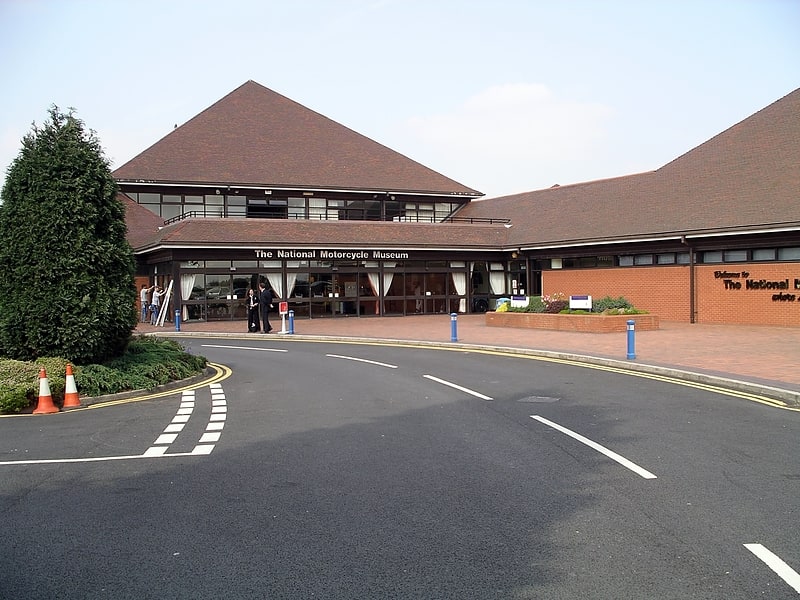
Museum in Hampton-in-Arden, England. The National Motorcycle Museum occupies an 8-acre site in Bickenhill, Solihull, England and holds the world's largest collection of British motorcycles. In addition to over 850 motorcycles, which cover a century of motorcycle manufacture, the museum has conference facilities. It is located close to the junction of the A45 and the M42, close to Birmingham Airport.[33]
Address: Coventry Rd, B92 0EJ Bickenhill
Royal Pavilion, Brighton

Iconic Regency palace and museum. The Royal Pavilion, also known as the Brighton Pavilion, is a Grade I listed former royal residence located in Brighton, England. Beginning in 1787, it was built in three stages as a seaside retreat for George, Prince of Wales, who became the Prince Regent in 1811, and King George IV in 1820. It is built in the Indo-Saracenic style prevalent in India for most of the 19th century. The current appearance of the Pavilion, with its domes and minarets, is the work of architect John Nash, who extended the building starting in 1815. George IV's successors William IV, and Victoria, also used the Pavilion, but Queen Victoria decided that Osborne House should be the royal seaside retreat, and the Pavilion was sold to the city of Brighton in 1850.
On 1 October 2020, management and operation of the Royal Pavilion & Museums' buildings and collections were transferred from Brighton & Hove City Council to a new charity: the Royal Pavilion & Museums Trust.[34]
Address: 4/5 Pavilion Buildings, BN1 1EE Brighton (Regency)
Clifford's Tower, York
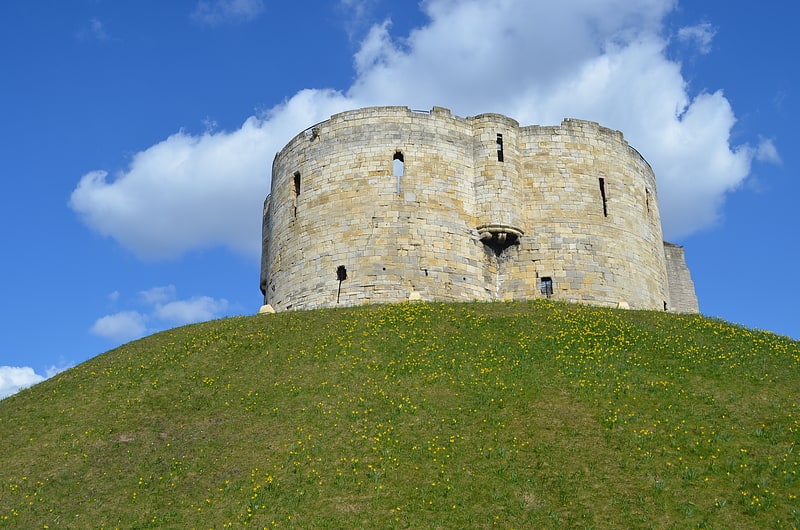
Castle keep once used a prison and mint. York Castle is a fortified complex in the city of York, England. It consists of a sequence of castles, prisons, law courts and other buildings, which were built over the last nine centuries on the south side of the River Foss. The now-ruined keep of the medieval Norman castle is commonly referred to as Clifford's Tower. Built originally on the orders of William I to dominate the former Viking city of Jórvík, the castle suffered a tumultuous early history before developing into a major fortification with extensive water defences. After a major explosion in 1684 rendered the remaining military defences uninhabitable, York Castle continued to be used as a jail and prison until 1929.
The first motte and bailey castle on the site was built in 1068 following the Norman conquest of York. After the destruction of the castle by rebels and a Viking army in 1069, York Castle was rebuilt and reinforced with extensive water defences, including a moat and an artificial lake. York Castle formed an important royal fortification in the north of England.
In 1190, 150 local Jews were killed in a pogrom in the timber castle keep; most of them died by suicide in order not to fall into the hands of the mob. Henry III rebuilt the castle in stone in the middle of the 13th century, creating a keep with a unique quatrefoil design, supported by an outer bailey wall and a substantial gatehouse. During the Scottish wars between 1298 and 1338, York Castle was frequently used as the centre of royal administration across England, as well as an important military base of operations.
York Castle fell into disrepair by the 15th and 16th centuries, becoming used increasingly as a jail for both local felons and political prisoners. By the time of Elizabeth I the castle was estimated to have lost all of its military value but was maintained as a centre of royal authority in York. The outbreak of the English Civil War in 1642 saw York Castle being repaired and refortified, playing a part in the Royalist defence of York in 1644 against Parliamentary forces. York Castle continued to be garrisoned until 1684, when an explosion destroyed the interior of Clifford's Tower. The castle bailey was redeveloped in a neoclassical style in the 18th century as a centre for county administration in Yorkshire, and was used as a jail and debtors' prison. Prison reform in the 19th century led to the creation of a new prison built in a Tudor Gothic style on the castle site in 1825; used first as a county and then as a military prison, this facility was demolished in 1935. By the 20th century the ruin of Clifford's Tower had become a well-known tourist destination and national monument; today the site is owned by English Heritage and open to the public. The other remaining buildings serve as the York Castle Museum and the Crown Court.[35]
Address: Tower St., YO1 9SA York
Royal Crescent, Bath
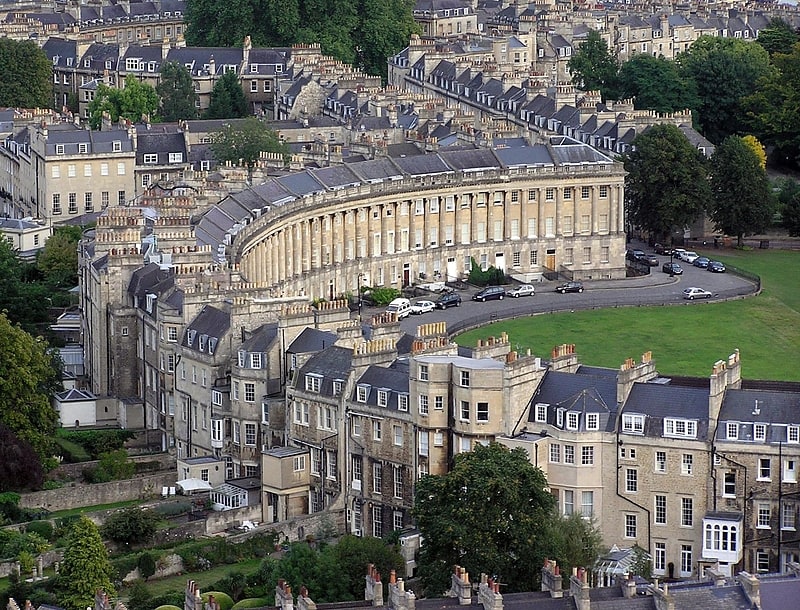
Building complex. The Royal Crescent is a row of 30 terraced houses laid out in a sweeping crescent in the city of Bath, England. Designed by the architect John Wood, the Younger and built between 1767 and 1774, it is among the greatest examples of Georgian architecture to be found in the United Kingdom and is a Grade I listed building. Although some changes have been made to the various interiors over the years, the Georgian stone facade remains much as it was when first built.
The 500-foot-long (150 m) crescent has 114 Ionic columns on the first floor with an entablature in a Palladian style above. It was the first crescent of terraced houses to be built and an example of "rus in urbe" (the country in the city) with its views over the parkland opposite.
Many notable people have either lived or stayed in the Royal Crescent since it was built over 240 years ago, and some are commemorated on special plaques attached to the relevant buildings. Of the crescent's 30 townhouses, 10 are still full-size townhouses; 18 have been split into flats of various sizes; one is the No. 1 Royal Crescent museum and the large central house at number 16 is The Royal Crescent Hotel & Spa.[36]
Address: Royal Cres, BA1 2LS Bath
Queen Street, Cardiff
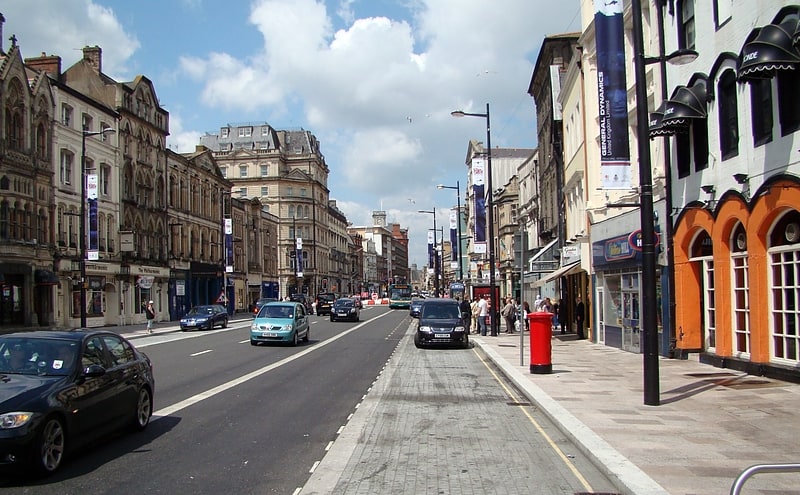
Street in Cardiff, Wales. St Mary Street and High Street are major commercial streets in the Castle Quarter of Cardiff city centre, Wales, which form a major thoroughfare running south from the gatehouse of Cardiff Castle. High Street begins at the junction of Castle Street on the A4161 and ends at the junction of Church Street and Quay Street, from where St Mary Street begins until the roundabout at Callaghan Square on the A4160.[37]
Address: Queen St, CF10 Cardiff (Canol Dinas Caerdydd)
Harewood House, Leeds

Art-filled country house and bird garden. Harewood House is a country house in Harewood, West Yorkshire, England. Designed by architects John Carr and Robert Adam, it was built, between 1759 and 1771, for Edwin Lascelles, 1st Baron Harewood, a wealthy West Indian plantation and slave-owner. The landscape was designed by Lancelot "Capability" Brown and spans 1,000 acres at Harewood.
Still home to the Lascelles family, Harewood House is a member of the Treasure Houses of England, a marketing consortium for ten of the foremost historic homes in the country. The house is a Grade I listed building and a number of features in the grounds and courtyard have been listed as Grade I, II* and II.[38]
Leeds Corn Exchange, Leeds

Building in Leeds, England. The Leeds Corn Exchange is a Victorian building and former corn exchange in Leeds, West Yorkshire, England, which was completed in 1863. It is a grade I listed building.[39]
Address: Call Ln, LS1 7BR Leeds (City and Holbeck)
Spinnaker Tower, Portsmouth
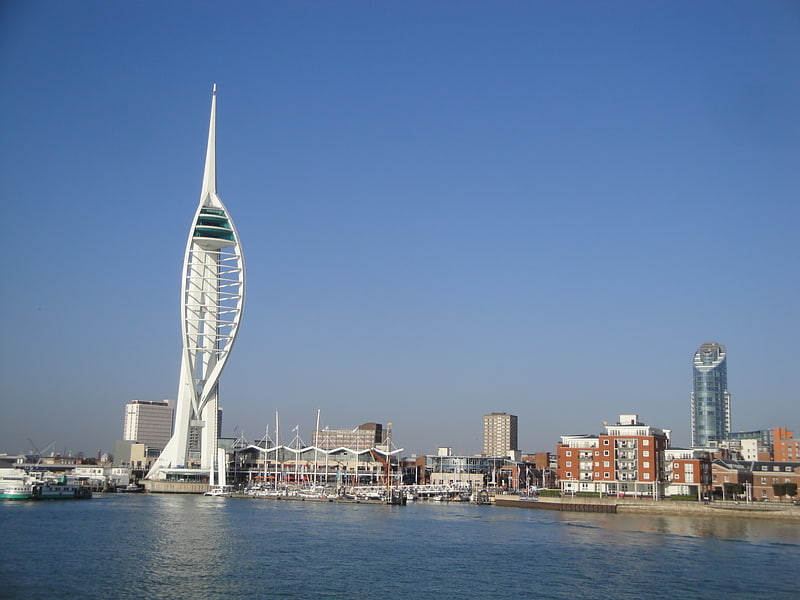
Sail-like tower with panoramic views. The Spinnaker Tower is a 170-metre landmark observation tower in Portsmouth, England. It is the centrepiece of the redevelopment of Portsmouth Harbour, which was supported by a National Lottery grant. The tower's design was chosen by Portsmouth residents from a selection of three different designs in a 1998 public poll. It has three viewing platforms one on top of the other at heights of 100 m, 105 m and 110 m.
The tower was designed by local firm HGP Architects and engineering consultants Scott Wilson and built by Mowlem. The Spinnaker Tower reflects Portsmouth's maritime history through its design and is named after a spinnaker, a type of sail that balloons outward. The tower was opened on 18 October 2005.
The tower is owned by Portsmouth City Council and is operationally managed by Continuum Leading Attractions, a cultural attractions group based in York. Continuum also runs five other visitor attractions across the country.
The Spinnaker Tower was repainted and rebranded as the "Emirates Spinnaker Tower" from July 2015 following a five-year commercial sponsorship deal with Dubai-based Emirates airline. The Emirates sponsorship deal expired in 2020 and the tower reverted to its original all-white paint scheme and name in April 2021.[40]
Address: Gunwharf Quays, PO1 3TT Portsmouth
Tropical World, Leeds

Tropical World is a butterfly house and animal attraction located in Leeds, West Yorkshire, England. It is a licensed zoo with membership of BIAZA and also features the largest collection of tropical plants outside Kew Gardens.[41]
Address: Canal Gardens, LS8 1DE Leeds
Hull and East Riding Museum, Kingston upon Hull
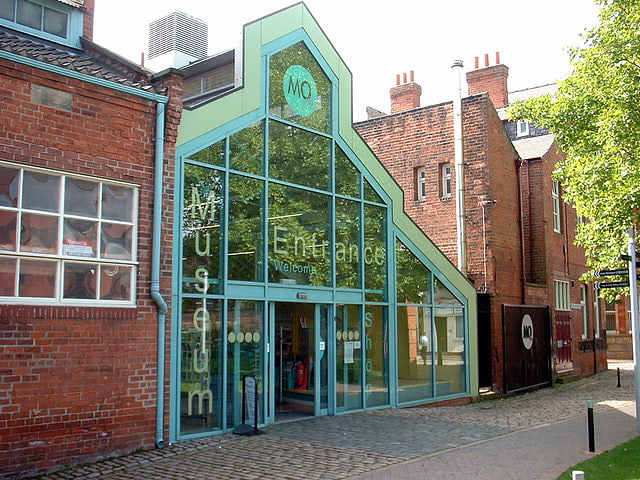
Museum. The Hull and East Riding Museum is located in the Museums Quarter of the Old Town in Kingston upon Hull, England. It dates back to 1925 as the Museum of Commerce and Industry in a former Customs House but acquired its present name in 1989 with a major refurbishment and new entrance, with the transport section moving to a separate museum. It displays items from prehistoric to medieval in the area, many of them in life-size tableaux or reconstructions of rooms and buildings.[42]
Clarence Pier, Portsmouth

Amusement park in Portsmouth, England. Clarence Pier is an amusement pier in Portsmouth, Hampshire. It is located next to Southsea Hoverport. Unlike most seaside piers in the UK, the pier does not extend very far out to sea and instead goes along the coast.[43]
Address: Clarence Esplanade, PO5 3AA Southsea
Great Western Arcade, Birmingham
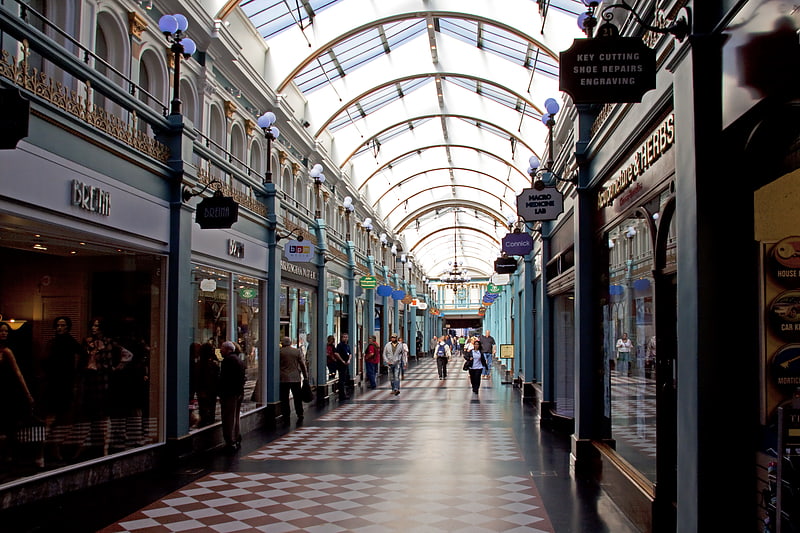
Shopping arcade in Birmingham, England. The Great Western Arcade is a covered Grade II listed Victorian shopping arcade lying between Colmore Row and Temple Row in Birmingham City Centre, England.
It was built (1875-6) over the Great Western Railway line cutting at the London end of Snow Hill station. The cutting was covered in 1874. Originally the broad gauge Paddington line ran through a tunnel which stopped at Temple Row and then an open cutting to Snow Hill station. The cutting was roofed over in 1874 and the Great Western Arcade built on top, the line of the new 'tunnel' being offset slightly to the north of the centre of the arcade. The extended tunnel has a length of 596 yards (545 m). The arcade was designed by W. H. Ward of Paradise Street, Birmingham.
The arcade has entrances at each end: that at Temple Row being ornate, unlike the modern reworking at Colmore Row, opposite the entrance to the station. The arcade's roof was originally a glazed semi-circular barrel vault with a glazed central dome, similar to that of the Gallerio Vittoria Emmanuele in Milan which was constructed at the same time. It was destroyed during World War II and has been replaced. The arcade, containing shops on both sides, has a clock which strikes the quarters on a set of five exposed bells.[44]
Address: Colmore Row, B2 5HU Birmingham
City Hall, Belfast
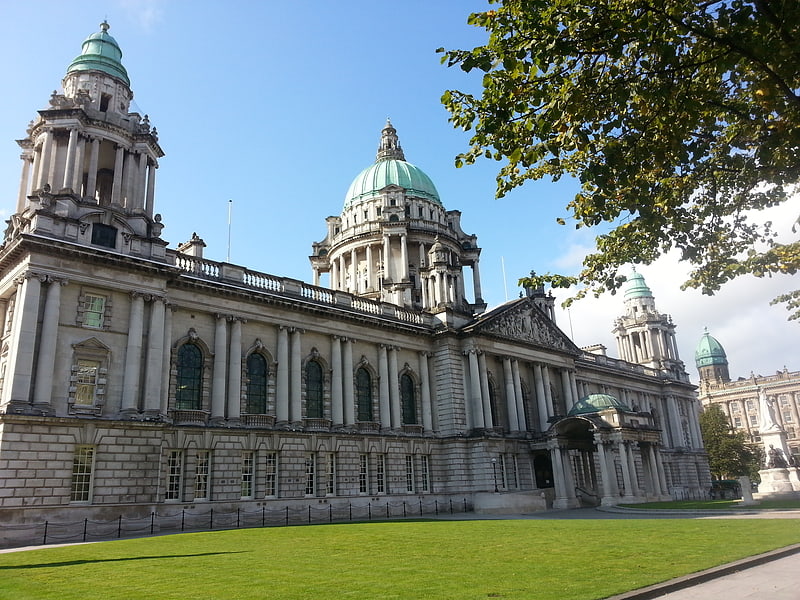
Grand government building with gardens. Belfast City Hall is the civic building of Belfast City Council located in Donegall Square, Belfast, Northern Ireland. It faces North and effectively divides the commercial and business areas of the city centre. It is a Grade A listed building.[45]
Address: City Hall Donegall Sq., BT1 5GS Belfast
British Airways i360, Brighton
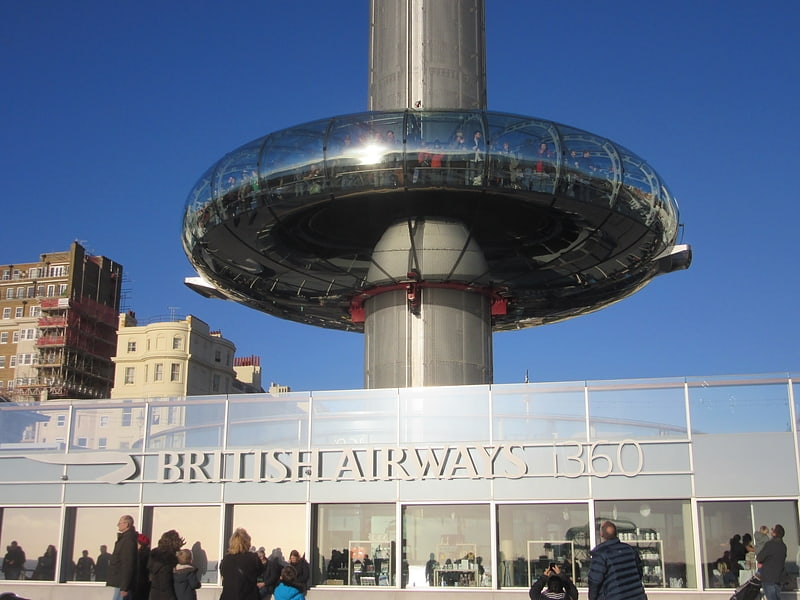
Tower in England. British Airways i360 is a 162 m observation tower on the seafront of Brighton, East Sussex, England at the landward end of the remains of the West Pier. The tower opened on 4 August 2016. From the fully enclosed viewing pod, visitors experience 360-degree views across Brighton, the South Downs and the English Channel.
British Airways i360 was designed, engineered, manufactured and promoted by the team responsible for the London Eye. The attraction cost £46 million, with £36 million being funded by a Public Works Loan Board (PWLB) loan through Brighton and Hove city council.
Formerly known as the "Brighton i360", the project aimed to attract 739,000 paying customers every year. The owner of the site, the West Pier Trust, hoped in 2014 that a successful i360 would lead to the rebuilding of the historic West Pier.[46]
Address: Lower Kings Road, BN1 2LN Brighton (Regency)
Deva Victrix, Chester
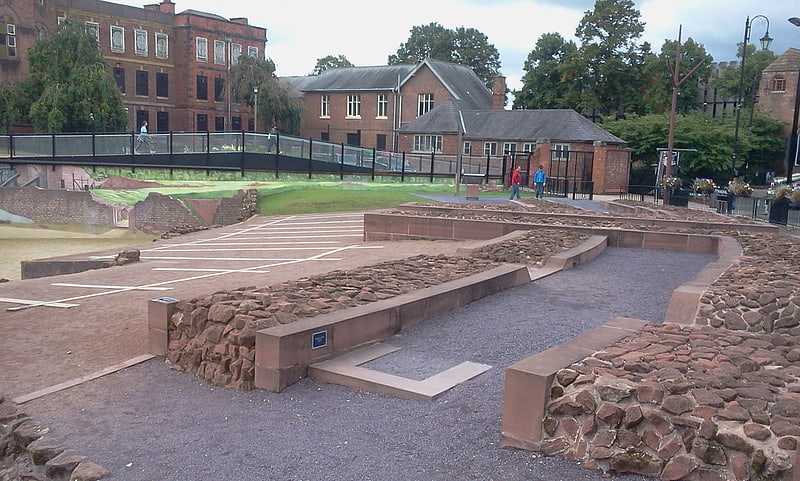
Deva Victrix, or simply Deva, was a legionary fortress and town in the Roman province of Britannia on the site of the modern city of Chester. The fortress was built by the Legio II Adiutrix in the 70s AD as the Roman army advanced north against the Brigantes, and rebuilt completely over the next few decades by the Legio XX Valeria Victrix. In the early 3rd century the fortress was again rebuilt. The legion probably remained at the fortress until the late 4th or early 5th century, upon which it fell into disuse.
A civilian settlement, or canabae, grew around the fortress. Chester's Roman Amphitheatre, south-east of the fortress, is the largest-known military amphitheatre in Britain. The civilian settlement remained after the Romans departed, eventually becoming the present-day city of Chester. There were peripheral settlements around Roman Deva, including Boughton, the source of the garrison's water supply, and Handbridge, the site of a sandstone quarry and Minerva's Shrine. The shrine is the only in situ, rock-cut Roman shrine in Great Britain.
The fortress contained barracks, granaries, headquarters, military baths, and an unusual elliptical building which had it been finished may have been intended to act as the governor of Britain's headquarters.[47]
Parker's Piece, Cambridge
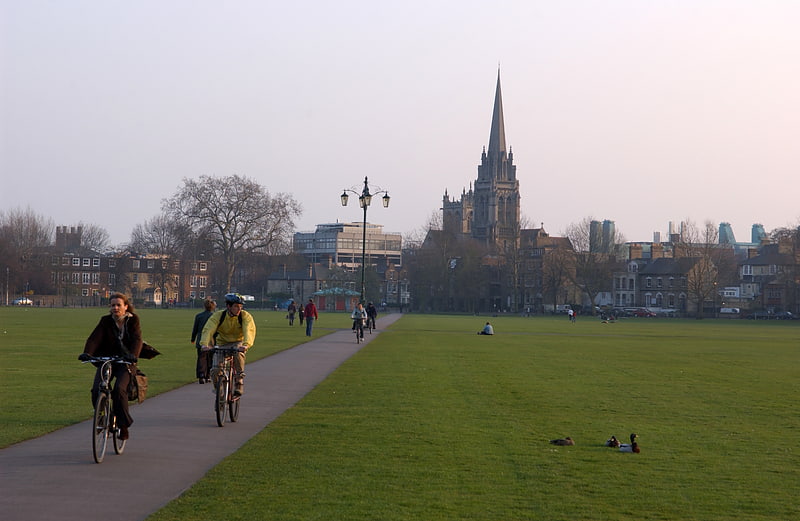
Park in Cambridge, England. Parker's Piece is a 25-acre flat and roughly square green common located near the centre of Cambridge, England, regarded by some as the birthplace of the rules of Association Football. The two main walking and cycling paths across it run diagonally, and the single lamp-post at the junction is colloquially known as Reality Checkpoint. The area is bounded by Park Terrace, Parkside, Gonville Place, and Regent Terrace. The Cambridge University Football Club Laws were first used on Parker's Piece and adopted by the Football Association in 1863. "They embrace the true principles of the game, with the greatest simplicity". 'The Cambridge Rules appear to be the most desirable for the Association to adopt'.
The grass is mown and the area is known today chiefly as a spot for picnics and games of football and cricket, and serves as the games field for nearby Parkside Community College. Fairs tend to be held on the rougher ground of Midsummer Common.
In 1838, a feast for 15,000 guests was held on Parker's Piece to celebrate the coronation of Queen Victoria.[48]
Address: Gonville Place, CB1 1LY Cambridge
Royal Albert Memorial Museum, Exeter
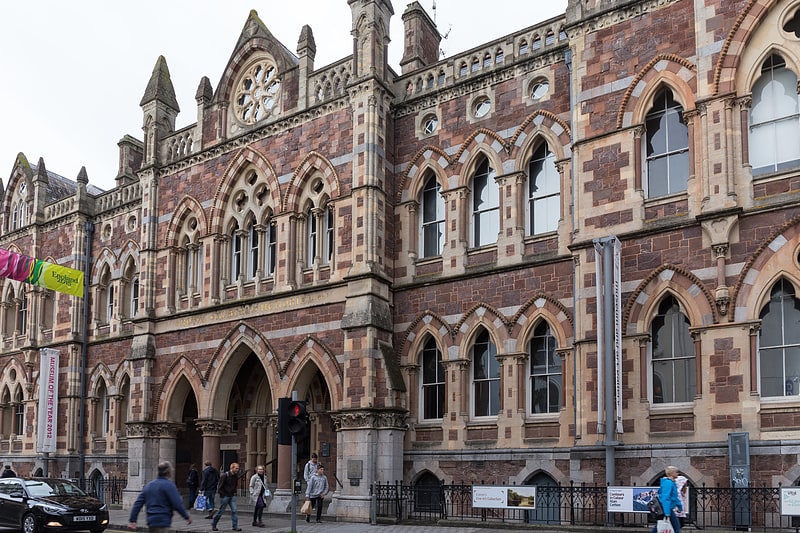
Museum in Exeter, England. Royal Albert Memorial Museum & Art Gallery is a museum and art gallery in Exeter, Devon, the largest in the city. It holds significant and diverse collections in areas such as zoology, anthropology, fine art, local and overseas archaeology, and geology. Altogether the museum holds over one million objects, of which a small percentage is on permanent public display. It is a 'Major Partner Museum' under the Arts Council England administered programme of strategic investment, which means RAMM receives funding to develop its services. RAMM receives this funding in partnership with Plymouth City Museum & Art Gallery. Previously they were described as 'hub museums' under the 'Renaissance' Programme for regional museums which operated between 2002–11 and funded by the now defunct Museums Libraries & Archives Council.
Founded in 1868, the museum is housed in a Gothic Revival building of local New Red Sandstone that has undergone several extensions during its history; most recently, the museum was re-opened on 15 December 2011 after a redevelopment lasting four years and costing £24M. Since its re-opening the museum has received several awards.[49]
Address: Queen St, EX4 3RX Exeter
Botanic Gardens, Belfast
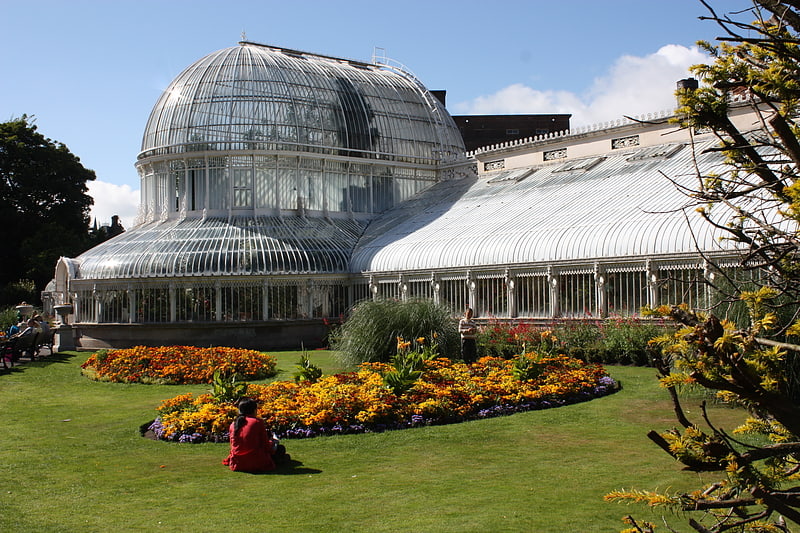
Lush park with a Victorian glasshouse. Botanic Gardens is a public garden in Belfast, Northern Ireland.
Occupying 28 acres (110,000 m2) of south Belfast, the gardens are popular with office workers, students and tourists. They are located on Stranmillis Road in Queen's Quarter, with Queen's University nearby. The Ulster Museum is located at the main entrance.[50]
Address: College Park, BT9 5AB Belfast